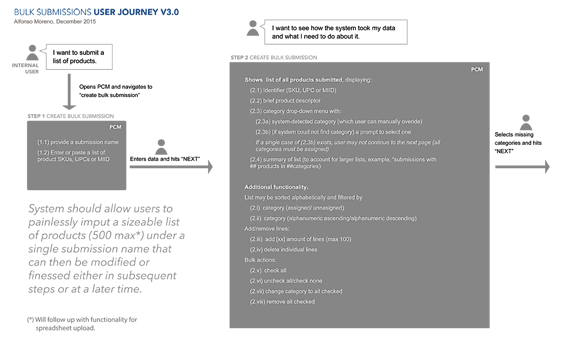Best Buy's Product Selection Tool

Challenge
Following my tenure in Best Buy’s Digital Experience team as lead designer for Omnichannel, I put in a few years leading the UX for the enterprise tools division. The work was not sexy from a graphic perspective but tremendously fulfilling to the interaction designer I’ve always been :). In this particular case, I was asked to help evolve one of their legacy product management tools which had started out, as these things often do, as a well-intentioned enhancement to the previous excel-sheet system product managers had been using, but which naturally devolved in time to a bloated, cumbersome program infested with featuritis, which solved few of the users’ pain-points and made their lives harder rather than easier.
Approach
The single, most valuable advantage of building internal enterprise tools, is that you have your end-users right there, in-house. The disadvantage? That those same users are often the same people you must rely on as subject matter experts. So, for that very reason, they can warp your validation process. It took some time, for this reason, to identify subjects with whom to white board ideas versus those better suited for testing. As an example, a number of CMs working remotely proved very useful answering surveys to get us started. Once assumptions were outlined and validated, some wireframe work helped identify the scope of the experience, which was further broken down into technical user stories and weaved into the every day agile cadence for final build.
Results
The work was extremely successful and proved a game-changer in what had been, up until then, and as I said before, excel sheets on digital steroids. Not only were we able to improve massively on the previous experience but a couple of the teams learned how to tie higher level conceptual design work into hands-on, tactical implementation, leveraging user stories not just as feature logs but as effective ways to define experience outcomes beyond the cold system requirements that, more often than not, end up clashing with en-user needs if proper context has not been accounted for.
WHAT
Product Content Management System
(single UX resource within agile team)
WHO
Best Buy
WHEN
2015
building on precedence
Before arriving to the glossy, final redesigned product, much down-and-dirty iterating with quick wireframes was done to improve the previous version, sprint-after-sprint. We iterated always on the real product, testing and validating as we moved along. By the time we received marching orders to redesign, the old version was already half-way there.
 lfonso moreno
lfonso moreno



